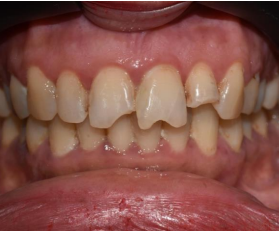Abstract
Introduction : This case report presents the successful restoration of a patient's smile using ceramic veneers to treat fractured maxillary anterior teeth. A 47-year-old female sustained trauma resulting in fractures to the maxillary central incisors. Dissatisfied with the appearance of her smile, she sought a durable and aesthetically pleasing solution. Ceramic veneers, known for their strength and excellent aesthetic properties, were selected as the treatment of choice. Methodology : The treatment plan involved the application of lithium disilicate ceramic veneers. After obtaining the patient's consent, minimal tooth preparation was performed to preserve the natural tooth structure. Precise impressions were taken, and custom veneers were fabricated in a dental laboratory. The veneers were bonded to the fractured maxillary central incisors using adhesive cement, ensuring a strong and durable fit. Discussion : Lithium disilicate ceramic veneers were chosen due to their high translucency, color matching capabilities, and strength, making them ideal for anterior restorations. The minimal tooth preparation preserved the enamel, which enhances bonding efficacy and longevity. Ceramic veneers offer predictable and durable aesthetic outcomes in cases of dental trauma affecting the anterior region. This case demonstrates the veneers’ ability to mimic the natural tooth’s appearance while providing strength and longevity. The patient was highly satisfied with the restoration, reporting improved confidence in her smile. Results : At the 12-month follow-up, the ceramic veneers were intact, with no complications such as chipping, discoloration, or detachment. The patient expressed continued satisfaction with the aesthetic outcome. The excellent color match and translucency of the veneers contributed to a natural and harmonious smile, with the restoration proving to be a successful long-term solution.KEYWORDS : Aesthetic restoration , Ceramic veneers , Dental trauma , Fractured axillary anterior teeth , Lithium disilicate.

This work is licensed under a Creative Commons Attribution-NonCommercial-NoDerivatives 4.0 International License.
Copyright (c) 2024 Oral Sphere Journal of Dental and Health Sciences





